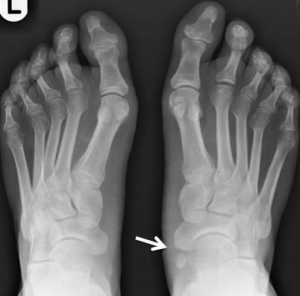What causes accessory navicular syndrome?
While the exact reason for the development of the accessory navicular bone itself is unknown, there is thought to be a genetic factor involved for some people. Accessory navicular syndrome is caused by irritation or damage to the area of the navicular and the surrounding soft tissues. This may occur from:- Abnormal foot biomechanics, particularly a flatter foot type
- Impact trauma to the inside of the foot
- An injury such as ankle sprains
- Tight footwear that rubs against the accessory navicular
- Overuse of the posterior tibial tendon and surrounding soft tissues
 What are the symptoms?
What are the symptoms?
Some people with an accessory navicular will remain asymptomatic throughout their lifetime and may never even know they have an accessory navicular. For others, painful symptoms can develop. Symptoms may begin during growth spurts and periods of bone maturity between the ages of 8 – 16 years, or may not begin until adulthood. Symptoms may include:
- Pain on the inside of the foot and arch
- Swelling
- Redness
- A visible bony bump on the inside of the foot just up from the ankle
- Pain exacerbated by physical activity and when standing on tip-toes
How is it treated?
Treatment begins with relieving the painful symptoms through the resting and icing the foot. Following this, the focus is on relieving strain and pressure away from the area of the navicular to reduce the likelihood of irritation and the symptoms coming back. This may involve:- Orthotics to support the medial foot border and arch and reduce pressure away from the navicular and surrounding soft tissues, and address abnormal foot biomechanics
- Footwear assessment to ensure that the shoes are helping and not hindering recovery, and are not prone to rubbing against the accessory navicular
- Physical therapy to stretch and strengthen surrounding musculature that may be placing greater strain in the region of the navicular or that are weakened by the injury
- Braces or boots may be used in more severe cases to immobilise the foot and completely off-load any pressure from the navicular








